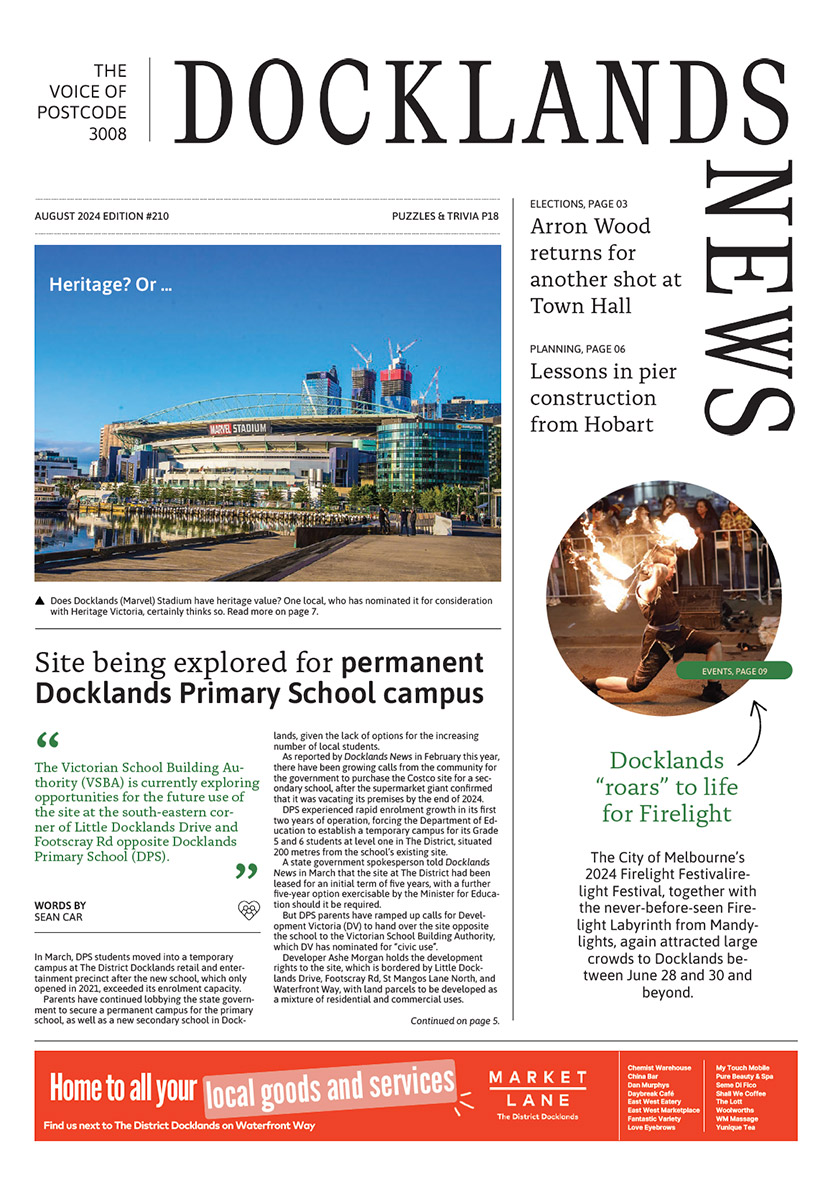Lessons in pier construction from across the strait
The engineer behind the state-of-the-art floating Brooke Street Pier in Tasmania spoke at an event at Docklands in July, raising questions for Docklanders about the best way to construct and activate Central Pier.
On July 5 at AFL House, the Melbourne Maritime Heritage Network (MMHN) hosted Brooke Street Pier’s engineer Jim Gandy who shared his experiences designing the world-renowned pier and the left-of-field construction methods that were used to bring it to life.
The 80-metre by 20-metre pier that now sits in Sullivans Cove in Hobart cost a total of $13 million and was completed within 60 weeks.
Due to the pier being in a densely populated area of Hobart where there was a busy nightlife, tourist trade and lots of pedestrians, Mr Gandy decided that the best option was to construct the pier off-site.
According to the pier’s designer, constructing the pier at Sullivans Cove would have disrupted the “flow” of the city and the noise caused during building would have reverberated around the harbour.
By constructing the pier offsite at Prince of Wales Bay, the disruption caused to the adjacent area in Hobart was only for a few weeks while the tourist hub was built, as opposed to over a year if they were to construct the entire pier there.
Once the concrete base was built, it was towed by two tugboats eight kilometres down the Derwent River to Sullivans Cove for its completion as a four-storey lightweight tourist hub.
Since Brooke Street Pier officially opened in 2015 it has become the home to some of Hobart’s premier restaurants, bars, cafes, and the twilight market.
The pier also has two ferry terminals and is the gateway to a range of unique Tasmanian experiences, with The Mona Roma fast ferries taking day-trippers to the renowned Museum of Old and New Art.
MMHN chair and former City of Melbourne councillor Dr Jackie Watts is advocating for a similar approach to be adopted for the construction and activation of Central Pier in Docklands.
Dr Watts said that it is both “feasible” and “economic” and “it cuts the nuisance value to zero” because the majority of construction would be completed offsite.
However, before any plans for Central Pier are laid out, she said heritage, community benefit and maritime industry aspirations all needed to be considered.
The MMHN has recently proposed a “bold new vision” for the pier’s activation through the construction of a Maritime Experience Centre (MEC).
It’s a proposal that it believes provides an opportunity for Victoria to recapture the “Marvelous Maritime Melbourne” of the past, and to prioritise innovative approaches to sustainable building and floating pier technology.
The centre would be a low-rise, three-level structure on a floating pier, attached to and accessible from Harbour Esplanade where Central Pier once stood.
Dr Watt’s vision for the MEC is for it to be a unique cultural heritage centre that would facilitate awareness of maritime endeavours, and would amuse, inform, and educate through the use of entertaining, creative technologies.
In 2022, Central Pier’s owner Development Victoria (DV) undertook an engagement process to find out what the community thought was important in the future through online and in-person workshops and an online survey.
Of the just shy of 300 respondents, DV said that a majority shared long-term vision for Harbour Esplanade and Central Pier to become a world-class waterfront destination.
The consultation also revealed that community members want the pier to reconnect the city to its harbour and attract people from all over to experience and enjoy Docklands.
With no designs of Central Pier shown to the public and details of its construction yet to be revealed, the question begs as to whether or not Development Victoria will look to Brooke Street Pier for any inspiration. •

Nick Reece picks Roshena Campbell as his running mate








 Download the Latest Edition
Download the Latest Edition